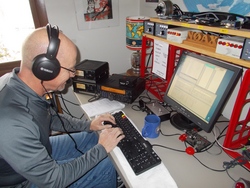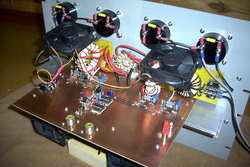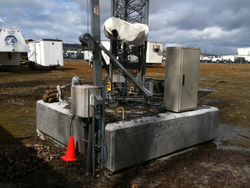 November 18, 2015 Editor: Paul Bourque, N1SFE | ||||
IN THIS ISSUE
NEW HF OPERATORS - THINGS TO DO
"The ARRL Sweepstakes Phone contest will be underway this weekend. If you are new to Sweepstakes (SS), you will quickly discover it is a terrific opportunity to work stations all over the US and Canada (including territories and possessions.) It doesn't require a huge station either - 100 watts and simple antennas will do a great job. Check out the ARRL November Sweepstakes webpage for the rules and some operating tips. Work at least 100 stations and you can get one of the popular Participation Pins for 2015. An even bigger challenge: Make contact with each of the 83 section multipliers and qualify for a 2015 Clean Sweep Mug. Try to get 'in the rhythm' with the lengthy Sweeps exchange. Write out the format on a card to help you remember the correct order of information. Don't forget that your callsign should be included as part of the exchange - and please use standard phonetics. Take a breath, then say it clearly and smoothly - once is usually enough - no need for "please copy" or "you are", just give the exchange. So jump in, make some QSOs, and share in the fun of the oldest domestic contests." -- Larry, K5OT, Sweepstakes contest manager BULLETINS Another new contest! In the new UK/EI DX Contest, United Kingdom and Ireland Amateurs are "home" while the rest of the world is "DX." The SSB side of the event occurs on December 5-6, 2015, and CW is January 23-24, 2016. Just for 2015 and 2016, all contest entrants work all other entrants for QSO points and multipliers. This should be a fun contest! Logs are due just TWO HOURS after the contest end! CONTEST SUMMARY Complete information for all contests follows the Conversation section November 19 November 20 November 21
November 25 November 26 November 27 November 28 December 2 Alfa Radio, makers of the AlfaSpid antenna rotator line, has appointed Hector Garcia authorized AlfaSpid service representative for the USA, effective immediately. APRS uses 2-meter frequencies to report location information. Transmissions are opportunistically received by listening stations, and can be combined with data from other receivers or information sources to provide maps showing autos, boats, etc. Whales are tracked via satellite when they are wintering off the west coast of the US . The transmitters are constructed to stay attached to a whale for a few months and provide location information by uplink of data through weather satellites. (AD7DR via PNWVHFS mailing list) There is more evidence that the "impossible" EmDrive spacecraft propulsion system actually works . Microwaves generated in a EmDrive motor's cavity are somehow generating very small accelerations in careful experiments. One theory on how it works involves a quantum plasma effect. The FCC continues to aggressively investigate cases of WiFi blocking, this time with a focus on convention centers. In the FCC's own media release, it cites violations of Section 333 of the Communications Act by causing malicious interference to lawful WiFi hotspots. Various laboratory and production facilities used for the Manhattan Project will be given a National Historic Park designation. These will qualify for the ARRL NPOTA activity (see #79 on the list)!
Something old, something new: 630 Meters (472 - 479 kHz) was alive with activity last weekend, as some amateurs in Canada used their relatively new privileges on the band to make cross-band contacts with US amateurs, and US experimental stations were providing MWL (Medium Wave Listener) opportunities. In a typical instance, a VE would transmit on 630 meters, and listen on 80 meters; the US ham would listen on 630 meters, and transmit on 80 meters. Some US amateurs have been operating under an experimental authorization, however that authorization does not strictly permit cross-band contacts. VE7SL described some of the activity on his blog, and notes that operation on these bands could be within the reach of most amateurs. In the early days of radio, 500 kHz could be used by 'amateurs' (and everyone else), but in 1912 non-commercial users of radio waves were restricted to frequencies at 200 meters and above. Over a dozen countries have approved Amateur Radio activity on 630 meters. US hams await the FCC's finalization of rules for operation on this band . Stay tuned for announcements of another 630-meter operating event in January or February 2016. Some rigs already have 630 meter receive capability; some may even have transmit capability with a new firmware load, and perhaps additional filtering. If you want to listen on 630 meters now, Eric, NO3M, listed a number of upconverters in a message to the TopBand mailing list . WORD TO THE WISE - "Octopus" Synonym for lockout, an octopus is a device that enforces a contest rule pertinent to multi-transmitter operation, usually to prevent two or more transmitters from transmitting simultaneously. It usually involves wires running to the transmitters involved, and so appears to have tentacles into each operating position. The Intel 4004 processor was released 44 years ago last week : November 15, 1971. As the first commercially available microprocessor, it wasn't clear to the marketing folks at the time that it was a viable product. With over 2000 transistors, it was the first chip to incorporate on one die everything needed to be a general purpose CPU (Central Processing Unit). Boston's Computer History Museum recorded a number of lectures by computing industry pioneers, starting in 1979. It's now releasing them via their web site and YouTube. Some of these describe very early computing work - akin to how we as radio amateurs might view dynamos and spark gaps as they apply to modern communications techniques. Preliminary results for the ARRL October School Club Roundup have been posted. The November ARRL Frequency Measuring Test results are now available. Top-billing goes to twenty-six stations which were able to determine each of three frequencies on 40m, 80m, and 160m with less than a single-Hertz of error. "Special thanks to WA7BNM for developing and hosting both web sites on behalf of the ARRL, FMT management team led by K5CM, and LIMARC (SCR sponsor). " - Ward, N0AX Randy, K5ZD, Director of the CQ WW DX Contest: "Just 8.5 days after the end of the 2015 CQ WW DX Contest Phone, I am happy to report that the raw scores for all entries received by 3Nov2015 1830z are available on the web site. The raw scores are the calculated score before any log checking or other adjustments are made. These scores may not match what you submitted exactly as our country file may be different than yours and you may have some QSOs where the call/country could not be determined. These are NOT the final results. Scores may change by 5-10% (or more) depending on the log checking. Final results will appear in the March 2016 issue of CQ Magazine. " The complete results for the PreStew (Preliminary Stew Perry) Contest are available . Top spots went to KV4FZ, NO3M, K9JWV, LY7M, PA0O, and OL1A in their respective entry categories. As usual, the results announcement is humorous and informative. The Stew Perry Top Band Distance Challenge is December 26-27, 2015. Results for DX entries to the 2015 ARI International DX Contest have been published. The contest period was May 2-3, 2015. OPERATING TIP Work Duplicates. It's less disruptive to the rhythm of your run. It could be faster and less confusing than sending "WRK B4". In this era of computer logging, the caller must not have you in their log, so it's in your interest to have the Q, too. This operating tip was given earlier this year, so it itself is a duplicate. Or is it?
When I was getting some equipment ready for Sweepstakes, I needed to use the handshaking lines on nine-pin serial connector. Web sites like www.hardwarebook.info, pinouts.ru , allpinouts.org, and others provide a ready reference for all sorts of connectors and signals that you might encounter. Steve, N2IC submits: "I noticed your link to a DIY TDR article. One thing not included in the article is how to make your own pulse generator. I have been using the circuit from this article for many years. (It's) simple and inexpensive to build. It doesn't generate the most perfect square pulse, but it lets me quickly look for faults, such as coax cable damage. Sadly, I have learned how easy it is to damage 1/2" Heliax!" "This Instructables includes a very useful collection of Color Codes for Resistors, Capacitors, ... ICs . Handy reference. " - Frank K5HS "Since we are entering low-band season in the Northern Hemisphere, lots of new boxes are being installed for specialized receiving antennas. Researchers find that an electrically driven shock wave can be used to desalinate water. A gradient of salinity can be induced across a cross-section of flowing water, and then a simple mechanical divider can be used to separate the streams. "Using FM to Improve WiFi Networks:" Researchers demonstrated the use of non-WiFi frequencies to coordinate between geographically adjacent access points to maximize throughput . Check that connector before forcing it in! Learn from my recent experience that if a connector isn't connecting easily, make sure that the male and female are of the same type. While building a cable to interface a bandpass filter to a Yaesu rig, I encountered an 8-pin socket connector that didn't match the 8-pin plug, despite being visually similar. Too much enthusiasm on my part could have damaged a very expensive radio. Technical Web Site of the Week - http://amasci.com/amateur/transis.html This article explains P-N transistor operation by focusing on depletion regions. If you'd like to do a little experimenting with constructing your own transistors, towards the end of this article on how transistors work, suggestions are made on possible fabrication methods using a galena crystal and "cat whiskers", germanium diodes, or the (larger) dies of older audio power transistors. Old and New Frontiers Licensed amateurs in the US may shortly have access to the 630-meter and 2200-meter bands. While it will be "new" to today's hams, these frequencies are closer to where radio started at the beginning of the last century. We'll be re-acquainting ourselves with the physical and propagation phenomena that the pioneers of radio encountered, though we'll have the benefit of modern measurement techniques, off-the-shelf parts, over 100 years of technical expertise to draw upon to generate and detect radio signals, and a global network to support real-time experimentation. It may still be difficult to make trans-oceanic contacts on these bands, which should make the communication achievements of the early experimenters and inventors all the more impressive. When today's researchers are able to entangle photons and demonstrate action-at-a-distance quantum effects, it doesn't seem related to what we enjoy as our radio hobby, but fundamentally, it's still communication. A better understanding of how matter and energy really interact, or perhaps statistically interact, may lead to new electronic devices, to new ways we can convey information and transform energy. Today's researchers use lasers, optics, precise manipulation of particle and wave properties, and so on; "unconventional kit" to us today, but in how many years will we radio experimenters and hobbyists be able to experiment with new electronic devices that take advantage of some of the 'stranger' quantum effects to help us play radio better? In a decade or ten, perhaps we'll be talking about the new Mars multipliers, or how some of our superposed packets just won't resolve. Looking back on today's practices, hams of the future may well consider how odd it was that radio contests had fixed durations, that log data wasn't entirely checked against all other entries, that it could take a few months before contest results were determined, that you were generally only in one contest at a time, and how many of technologies that they use in the casual pursuit of their hobby weren't considered 'radio' in 2015. 73, Brian N9ADG 19 Nov - 2 Dec 2015 An expanded, downloadable version of QST's Contest Corral in PDF format is available. Check the sponsor's Web site for information on operating time restrictions and other instructions. HF CONTESTS CWops Mini-CWT Test , Nov 18, 1300z to Nov 18, 1400z, Nov 18, 1900z to Nov 18, 2000z, Nov 19, 0300z to Nov 19, 0400z; CW; Bands: 160, 80, 40, 20, 15, 10m; Member: Name + Member No., non-Member: Name + (state/province/country); Logs due: November 21. VHF+ CONTESTS
ARRL EME Contest , Nov 28, 0000z to Nov 29, 2359z; CW, Phone, Digital; Bands: 50-1296 MHz; Signal report; Logs due: January 1. LOG DUE DATES 19 Nov - 2 Dec 2015
November 19, 2015 November 20, 2015 November 21, 2015 November 22, 2015 November 23, 2015 November 24, 2015 November 28, 2015 November 29, 2015 November 30, 2015 December 1, 2015 ARRL Information Click here to advertise in this newsletter, space subject to availability. Your One-Stop Resource for Amateur Radio News and Information ARRL membership includes QST, Amateur Radio's most popular and informative journal, delivered to your mailbox each month. Subscribe to NCJ - the National Contest Journal. Published bimonthly, features articles by top contesters, letters, hints, statistics, scores, NA Sprint and QSO Parties. Subscribe to QEX - A Forum for Communications Experimenters. Published bimonthly, features technical articles, construction projects, columns and other items of interest to radio amateurs and communications professionals. Free of charge to ARRL members: Subscribe to The ARRL Letter (weekly digest of news and information), the ARES E-Letter (monthly public service and emergency communications news), Division and Section news -- and much more! ARRL offers a wide array of products to enhance your enjoyment of Amateur Radio. Visit the site often for new publications, specials and sales. Donate to the fund of your choice -- support programs not funded by member dues! Reprint permission can be obtained by sending email to permission@arrl.org with a description of the material and the reprint publication. ACKNOWLEDGEMENTS ARRL Contest Update wishes to acknowledge information from WA7BNM's Contest Calendar and SM3CER's Contest Calendar. | ||||









